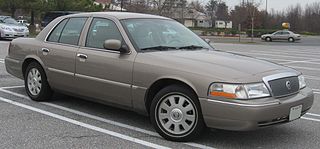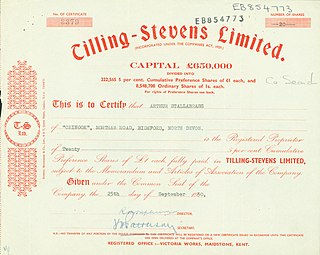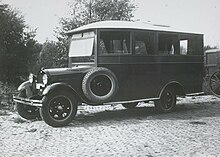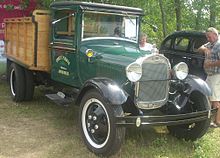
The Ford Model T is an automobile that was produced by the Ford Motor Company from October 1, 1908, to May 26, 1927. It is generally regarded as the first mass-affordable automobile, which made car travel available to middle-class Americans. The relatively low price was partly the result of Ford's efficient fabrication, including assembly line production instead of individual handcrafting. It was mainly designed by three engineers, Joseph A. Galamb, Eugene Farkas, and Childe Harold Wills. The Model T was colloquially known as the "Tin Lizzie", "Leaping Lena" or "flivver".

Four-wheel drive, also called 4×4 or 4WD, refers to a two-axled vehicle drivetrain capable of providing torque to all of its wheels simultaneously. It may be full-time or on-demand, and is typically linked via a transfer case providing an additional output drive shaft and, in many instances, additional gear ranges.

The Ford Explorer is a range of SUVs manufactured by Ford Motor Company since the 1991 model year. As the first four-door SUV produced by Ford, the Explorer was introduced as a replacement for the two-door Bronco II. Within the current Ford SUV range in North America, the Explorer is slotted between the Ford Edge and Ford Expedition. As with the Ford Ranger, the Explorer derives its name from a trim package previously offered on the Ford F-Series pickup trucks.

The Mercury Grand Marquis is an automobile that was sold by Mercury from 1975 to 2011. Introduced as the flagship sub-model of the Mercury Marquis, the Grand Marquis became a stand-alone model line for 1983, serving as the largest Mercury sedan. Subsequently, the model line would serve as the sedan counterpart of the Mercury Colony Park station wagon; it would later serve as the basis of the revived Mercury Marauder.

The Ford Expedition is a full-size three-row SUV, manufactured by Ford. Introduced for the 1997 model year as the successor of the Ford Bronco, the Expedition was the first full-size Ford SUV sold with a four-door body. For its entire production life, the Ford Expedition has been derived from the corresponding generation of the Ford F-150 in production, sharing some body and mechanical components. The fourth-generation Ford Expedition began production for the 2018 model year. Similar to the configuration of the Chevrolet Tahoe and Suburban, the Ford Expedition is sold in regular and extended lengths ; sold since 2007, the latter functionally serves as the replacement for the Ford Excursion.

The Ford Aerostar is a range of vans that was manufactured by Ford from the 1986 to the 1997 model years. The first minivan produced by Ford, the model line was marketed against the Chevrolet Astro/GMC Safari and the first two generations of the Chrysler minivans. Introduced shortly before the Ford Taurus, the Aerostar derived its name from its slope-nosed "one-box" exterior.

The GAZelle is a series of light commercial vehicles: pickup trucks, vans and minibuses made by Russian car manufacturer GAZ. At the time of the dissolution of the Soviet Union and transition to a market economy, the Russian automobile industry had not produced a much-demanded LCV similar to the Ford Transit or VW T4 class. The GAZelle shares many parts with the company's passenger cars, in fact, models produced until 1998 had the same grille. Riga Autobus Factory, which formerly manufactured minibuses for the whole USSR, remained in Latvia, now required its vehicles be sold to the now-foreign Russian market for hard currency. Responding to this market opportunity, GAZ swiftly developed its own LCV called GAZelle, that taken together with its lighter version Sobol now account for the majority of the Russian van and light truck market and has strong positions in the markets of other CIS countries, ranking as GAZ's most popular and successful products.

The Dodge Power Wagon is a four-wheel drive medium duty truck that was produced in various model series from 1945 to 1980 by Dodge. The Power Wagon name was revived for the 2005 model year as a four-wheel drive version of the Dodge Ram 2500. As a nameplate, "Power Wagon" continues as a special package of the four-wheel drive version of 3/4 ton Ram Trucks 2500 model.

Trojan was a British automobile manufacturer producing light cars between 1914 and 1965, and light commercial vehicles for a short time.

The Ford Bronco is a model line of SUVs manufactured and marketed by Ford. The first SUV model developed by the company, five generations of the Bronco were sold from the 1966 to 1996 model years. A sixth generation of the model line was introduced for the 2021 model year. The nameplate has been used on other Ford SUVs, namely the 1984–1990 Bronco II compact SUV and the 2021 Bronco Sport compact crossover.
Ford-O-Matic was the first automatic transmission widely used by Ford Motor Company. It was designed by the Warner Gear division of Borg Warner Corporation and introduced in 1951 model year cars, and was called the Merc-O-Matic when installed in Mercury branded cars and Turbo-Drive when installed in Lincoln branded cars. In contrast to Detroit Gear Division's three band automatic originally designed for Studebaker which became superseded by this unit, a variation of Warner Gear's three-speed unit named Ford-O-Matic continued to evolve later into Cruise-O-Matic named transmissions in 1958 and finally the FMX named transmissions in 1968. This line continued in production until 1980, when the AOD was introduced. Like Ford, variations of this same Borg Warner design were used by other automobile manufacturers as well, such as AMC, International Harvester, Studebaker, Volvo and Jaguar, each of them having the necessary unique adaptations required for the individual applications.

The Ford Explorer Sport Trac is a pickup truck that was manufactured and marketed by Ford Motor Company for the North American market. The first mid-sized pickup truck produced by Ford, the Sport Trac was marketed from the 2001 to the 2010 model years. Sized between the Ranger and the F-150, the Sport Trac largely competed against crew-cab variants of the midsize Chevrolet Colorado/GMC Canyon, Dodge Dakota, Nissan Frontier, and Toyota Tacoma.

The Ford Super Duty is a series of heavy-duty pickup trucks produced by the Ford Motor Company since the 1999 model year. Slotted above the consumer-oriented Ford F-150, the Super Duty trucks are an expansion of the Ford F-Series range, from F-250 to the F-600. The F-250 through F-450 are offered as pickup trucks, while the F-350 through F-600 are offered as chassis cabs.

Tilling-Stevens was a British manufacturer of buses and other commercial vehicles, based in Maidstone, Kent. Originally established in 1897, it became a specialist in petrol-electric vehicles. It continued as an independent manufacturer until 1950, when it was acquired by the Rootes Group.

The Singer Bantam is a car which was produced by Singer from 1936 to 1939. It was the first model from Singer to have an all-steel body, by Pressed Steel Company. It was offered as a new economy model at the 1935 Motor Show in London, replacing the earlier Singer Nine series.

The TatraT813 was a truck produced in Czechoslovakia by the Tatra company. It was produced from 1967 to 1982. The basic representative of this series was a military version of the 8×8 Kolos (Colossus), which was able to pull trailers up to a total weight of 100 tons. Tatra also produced a civilian version in either 6×6 or 4×4. After fifteen years of production, 11,751 vehicles were built in all modifications. Many units were exported to the USSR, East Germany, Romania and India.

The Bedford CA was a distinctive pug-nosed light commercial vehicle produced between 1952 and 1969 by Bedford in Luton, England.

The Chevrolet Van or Chevy Van is a range of vans that was manufactured by General Motors from the 1964 to 1996 model years. Introduced as the successor for the rear-engine Corvair Corvan/Greenbrier, the model line also replaced the panel van configuration of the Chevrolet Suburban. The vehicle was sold both in passenger van and cargo van configurations as well as a cutaway van chassis that served as the basis for a variety of custom applications.

Car controls are the components in automobiles and other powered road vehicles, such as trucks and buses, used for driving and parking.

Their new Daimler 22 horsepower full-size luxury car was first displayed by Daimler in April 1902 at The Automobile Club’s Exhibition in London's Agricultural Hall. Daimler had elected to drop their multiple old low powered designs and restrict themselves to this 22 horsepower and a pair of 9 or 12 horsepower cars to the same design as the 22 but more lightly constructed. The King’s not quite finished new Daimler 22 was reported to be the chief attraction of the show.
























